


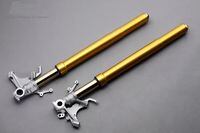
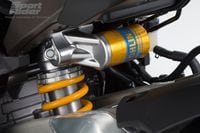


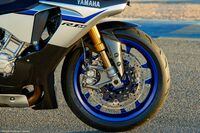
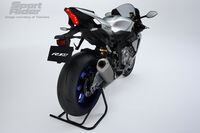
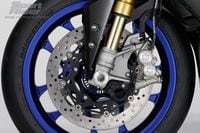
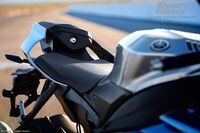
Yamaha's YZF-R1 is all-new for 2015, and the M version features Ohlins semi-active suspension and other upgrades. Here we take a closer look at the new bike and what distinguishes it from the standard model, through a selection of images provided by Yamaha. Scroll through the gallery above to learn more about the new YZF-R1M, and don't forget to watch our first laps on the 2015 R1M here, or read our ride review here.
Related articles:
/cloudfront-us-east-1.images.arcpublishing.com/octane/CTSWNU7SNNCC3LWB2KATYZ5AXY.jpg)
/cloudfront-us-east-1.images.arcpublishing.com/octane/72EPJVNA2VGVXJ2BVDFFLN67KQ.jpg)
/cloudfront-us-east-1.images.arcpublishing.com/octane/A7C4GNXEHNHC3LL6RETG6MIPPY.jpg)
/cloudfront-us-east-1.images.arcpublishing.com/octane/Q4KZ7ACKF5BVTE56LMG7RPJCEM.jpg)
/cloudfront-us-east-1.images.arcpublishing.com/octane/RQ2CXG6ATJBUZGUR7NP35C3VBE.jpg)
/cloudfront-us-east-1.images.arcpublishing.com/octane/MWSEWNFALBBJHOQGZTUUPVOQOU.jpg)
/cloudfront-us-east-1.images.arcpublishing.com/octane/LTPXG4ZHCVFNDNILFQ6PN6YUKI.jpg)
/cloudfront-us-east-1.images.arcpublishing.com/octane/EAEWHFARGVGHFH4N4BDOSNBJSU.jpg)
/cloudfront-us-east-1.images.arcpublishing.com/octane/AZ7H35TQSZDKZCVM4S6CHERQEU.jpg)
/cloudfront-us-east-1.images.arcpublishing.com/octane/GYMIU7SMN5CWHP6QLFR6MVKEBU.jpg)
/cloudfront-us-east-1.images.arcpublishing.com/octane/B3CX7C4BFFCKBLDWHPQFACBH2E.jpg)
/cloudfront-us-east-1.images.arcpublishing.com/octane/6EIBG7NN4BH4FKDBCPCTLQL6FU.jpg)
/cloudfront-us-east-1.images.arcpublishing.com/octane/3RBI4ZG5NNBCTEUK7MWMKVZ5BE.jpg)
/cloudfront-us-east-1.images.arcpublishing.com/octane/3QKLYI2BWVAMRNNFC5KCGUYRAU.jpg)
/cloudfront-us-east-1.images.arcpublishing.com/octane/B7ITEVP2MRGLXM37KQURRKCG3E.jpg)
/cloudfront-us-east-1.images.arcpublishing.com/octane/BMDGOMSLGFF7XDLBL5DVCTON6Y.jpg)
/cloudfront-us-east-1.images.arcpublishing.com/octane/AEPPASNAAJGXVLAXAH5RF3BDNY.jpg)
/cloudfront-us-east-1.images.arcpublishing.com/octane/QLJBI7Y3FBHNHCJZXWRPI5Y7GQ.jpg)
/cloudfront-us-east-1.images.arcpublishing.com/octane/CLGQ4ME2GFAELIWLGX6IKAAXFU.jpg)
/cloudfront-us-east-1.images.arcpublishing.com/octane/EOLKVNEXPFHHLAXEIZNJM3CKKI.jpg)
/cloudfront-us-east-1.images.arcpublishing.com/octane/QBH46BCX3BDXZHKYRAMLEFMJNA.jpg)
/cloudfront-us-east-1.images.arcpublishing.com/octane/SU3ENYMWOFBWRFKMQLOHIFUWPE.jpg)
/cloudfront-us-east-1.images.arcpublishing.com/octane/GY4WXPPLZZDWHI3X75YWKXOWI4.jpg)
/cloudfront-us-east-1.images.arcpublishing.com/octane/I67BZ2U3LJHQJP5IOC5AUIMKFE.jpg)